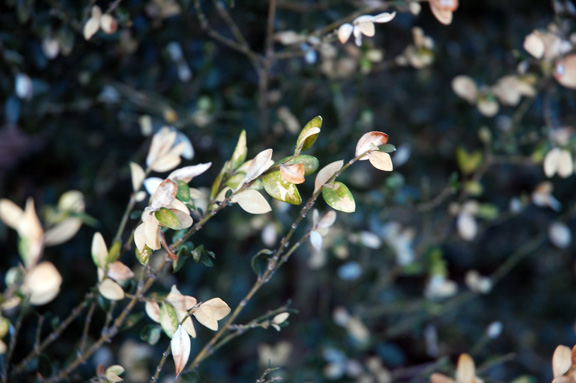
Woody > Buxus > Buxus sinica > Buxus sinica var. insularis 'Pincushion'
Buxus sinica
var. insularis 'Pincushion'
Pincushion Boxwood
Mike's
Opinion


"
A charming plant, one of the more diminutive boxwoods and as the name implies has the appearance of a pin cushion due to its protruding growth in the spring. Clipping as is common with boxwoods destroy this effect. A nice detail plant for the garden and as a winter foil.
Michael Pascoe, NDP., ODH., CLT., MSc. (Plant Conservation)
"
| Family |
| Buxaceae |
| Genus |
| Buxus |
| Species |
| sinica |
| Cultivar |
| 'Pincushion' |
| Category |
| Woody |
| Type |
| Shrub (evergreen) |
| Variety |
| insularis |
| USDA Hardiness Zone |
| 6 - 9 |
| Canadian Hardiness Zone |
| 5 |
| RHS Hardiness Zone |
| H7 |
| Temperature (°C) |
| -23 - (-29) |
| Temperature (°F) |
| -10 - (-20) |
| Height |
| 75 cm |
| Spread |
| 75 cm |
Photographs
Description and Growing Information
Flowering Period
| General Description |
| Low-mounded shrub with light green foliage. |
| Cultivation |
| Well drained soil, mulch with peat or leaf mold as roots like cool moist conditions. Full sun or light to moderate shade, protect from drying winds, has shallow roots. |
| Shape |
| Low-mounded. |
| Growth |
| Slow |
| ID Characteristic |
| Leaves are round ovate turning bronze in winter. |
| Pests |
| Spider mites may be an occasional problem in hot summers. As of late Boxwood blight has become a major problem both in Europe and most of North America. The fungus Cylindrocladium buxicola causes leaf spots, defoliation and even extensive die-back. The disease can be spread by water splash, tools and footwear and can survive for up to six years in the soil. It thrives in moist, humid environments but is killed when exposed to temperatures in excess of 33 °C for at least a week. The disease also affects Pachysandra, Sarocococca and Buxus balearica, sinica, macowanii, microphylla, bodinieri, glomerata, harlandii, sempervirens and riparia. |
| Habitat |
| Horticultural origin. |
| Bark/Stem Description |
| Slender, green, flat, grooved between each pair of leaves, sharply quadrangular. |
| Flower/Leaf Bud Description |
| Small, solitary, sessile, ovoid with 1-2 pairs visible. |
| Leaf Description |
| Rounded ovate, 8 mm long, light green turning bronze in winter. |
| Flower Description |
| Apetalous, axillary or terminal clusters,not showy but fragrant. |
| Fruit Description |
| Three-celled capsule, each valve 2 horned, shiney black. |
| Colour Description |
| Light green turning bronze in winter. |
| Texture Description |
| Medium-fine. |
| Notable Specimens |
| The Gardens of Fanshawe College Gardens (front of M building), London, Ontario, Canada. |
| Propagation |
| Propagate in mid-summer by taking semi-ripe cuttings from the current season's growth. Collect in the early morning using a sharp knife to cut pieces 10 - 15 cm in length. Remove all leaves from the lower third and pinch out any soft terminal growth. Dip into a number 2 rooting hormone, insert into trays or pots of cutting compost (50/50 mix of compost and sharp sand or perlite) and water well. Place in a propagator with bottom heat set at 15°C with or without mist; rooting should occur in 4 - 6 weeks. |
